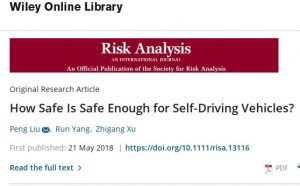
News
Self-driving cars need to be four times safer, and preferably 100x

The figure comes from Chinese research using a method not previously used to study self-driving vehicle safety perception – an ‘expressed-preference approach’.
“The results showed that the public will not accept this new technology unless it is shown to be safer, approximately four to five times as safe as human-driven vehicles,” said the Society. “Despite the conveniences self-driving vehicles would bring to individuals, the public will be much less likely to accept, or even tolerate, self-driving vehicles if they have the same risk level as human driving. As suggested by previous studies, an individual increases his or her demand for safety when that safety is entrusted to an external factor, such as an automated vehicle.”
The study was conducted by Tianjin University and Chang’an University, and findings based on 499 respondents from a survey distributed in the city of Tianjin.
Of respondents, half were randomly assigned to complete a version of the survey for human-driven vehicles, while the other half completed an self-driving vehicle version.
Risk frequencies were expressed as one fatality per a certain number of vehicle-km travelled and as one fatality per a certain number of population, respectively. Respondents were asked to accept or reject each traffic risk scenario at one of four levels: never accept, hard to accept, easy to accept and fully accept.
The results was the four to five times safer figure.
Current global traffic fatal risk is estimated at 17.4 per 100,000, which is 350 times greater than the frequency accepted by 50 percent of the respondents for self-driving vehicles, said the Society. This implies that respondents expect self-driving vehicles to improve safety by two orders of magnitude against the current traffic risk.
Based on the results, the researchers propose the following requirements for self-driving vehicles (SDVs) based on the tolerance of risk in industrial safety – a concept developed in the health and safety field – in which risks are distinguished by three criteria: unacceptable, tolerable and broadly acceptable.
- Unacceptable: SDVs less safe than human drivers
- Tolerable: SDVs four to five times as safe – so able to reduce 75-80% of current traffic fatalities
- Broadly acceptable: SDVs two orders of magnitude safer than current global traffic risk – 100-fold improvement – or the same order of magnitude experienced in public transport, such as rail and commercial aviation
According to the Society, human error is believed to cause 94% of all traffic crashes in the US and 75% in the UK. “While self-driving vehicles have the potential to significantly reduce these types of crashes, they also introduce several new road risks, including accidents caused by cyber-attacks. Creating perfectly safe self-driving vehicles is both technologically and economically infeasible, but policies can require that the risk of having them on the road be as low as technically achievable.”
Results are published in the paper ‘How safe is safe enough for self‐driving vehicles?‘, published in the journal Risk Analysis.